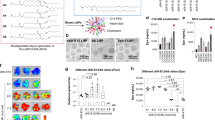Abstract
Purpose. The aim of this study was to evaluate the potential of fatty acids as shuttles to deliver xenobiotic inside the hepatocytes as well as to study the mechanism of incorporation into isolated hepatocytes when bound to native albumin or galactosylated albumin. Theoretically, they can enter into the hepatocytes after recognition of the Fatty Acid Binding Protein (FABPPM), or remain bound to galactosylated proteins and enter into these cells by a process known as receptor mediated endocytosis after selective recognition of the asialoglycoprotein receptor (ASGPR).
Methods. We synthesized a 3H-benzoyl adduct of lauric acid (BLA) (benzoyl adduct choosen to mimick any low molecular weight drug or contrast agent), and compared the behavior of BLA with oleic acid for their binding properties to carrier-proteins and the uptake mechanism by isolated hepatocytes.
Results. No significant difference was found in the binding properties of BLA for albumin and galactosylated albumin. The incorporation into the hepatocytes was found essentially depending on the FABPPM transport system whenever BLA was bound to albumin or to galactosylated albumin in the incubation medium: indeed, the transport was inhibited by phloretin (inhibitor of sodium dependent transport), increased when the free part of BLA was higher, and BLA was recovered in the cytosolic fraction of the hepatocytes.
Conclusions. This study showed the convenience in using fatty acids as drug carriers possessing tropism for the hepatocytes.
Similar content being viewed by others
REFERENCES
B. Gallez, R. Debuyst, R. Demeure, F. Dejehet, C. Grandin, B. Van Beers, H. Taper, J. Pringot, P. Dumont. Evaluation of a nitroxyl fatty acid as liver contrast agent for magnetic resonance imaging. Magn. Reson. Med. 30: 592–599 (1993).
B. Gallez, V. Lacour, R. Demeure, R. Debuyst, F. Dejehet, J.L. De Keyser, P. Dumont. Spin labelled arabinogalactan as MRI contrast agent. Magn. Reson. Imag. 12: 61–69 (1994).
W. Stremmel, H. Kleinert, A. Fitsher, J. Gunawan, C. Klaassen-Schlüter, K. Moller, M. Wegener. Mechanisms of cellular fatty acid uptake. Biochem. Soc. Trans. 20: 814–817 (1993).
Y.C. Lee. Biochemistry of carbohydrate-protein interaction. FASEB J. 6: 3193–3200 (1992).
D. Hesk, J.R. Jones, W.J.S. Lockley. Regiospecific deuteriation and tritiation of various drugs using a homogeneous rhodium chloride catalyst. J. Pharm. Sci. 80: 887–890 (1991).
B.A. Schwartz, G.R. Gray. Proteins containing reductively aminated disaccharides. Synthesis and chemical characterization. Arch. Biochem. Biophys. 181: 542–549 (1977).
G. Krack, O. Gravier, M. Roberfroid, M. Mercier. Subcellular fractionation of isolated rat hepatocytes. A comparison with liver homogenate. Biochim. Biophys. Acta 632: 619–629 (1980).
N.A. Abumrad, C. Perkins, J.H. Park, C.R. Park. Mechanisms of long-chain fatty acid permeation in the isolate hepatocyte. J. Biol. Chem. 256, 9183–9191 (1981).
C. De Duve. Principles of tissue fractionation. J. Theroret. Biol. 6: 33–69 (1964).
B. Gallez, J.L. De Keyser, R. Debuyst, F. Dejehet, L. Neuvens, P. Dumont. The effects of pasteurisation on albumin: An EPR binding assay for polymeric albumin. J. Pharm. Biomed. Anal. in press.
F. Atlasovich, J.A. Santome, H.N. Fernandez. Photoreactive fatty acid analogs that bind to the rat liver fatty acid-binding protein: 11-(5′-azido-salicylamido)-undecanoic acid derivatives. Mol. Cell. Biochem. 120: 15–23 (1993).
R. Zimmermann, B. Rauch, M. Kapp, B. Bubeck, F.J. Neumann, F. Seitz, P. Stockad, G. Mall, H. Tillmanns, W. Kubler. Myocardial scintigraphy with iodine-123 phenylpentadecanoic acid and thallium-201 in patients with coronary artery disease: a comparative dual-isotope study. Eur. J. Nucl. Med. 19, 946–954 (1992).
Y. Fujibayashi, P. Som, Y. Yonekura, F.F. Knapp, N. Tamaki, K. Yamamoto, J. Konishi, A. Yokoyama. Myocardial accumulation of iodinated beta-methyl-branched fatty acid analog, [125I](piodophenyl)-3-(R,S)-methylpentadecanoic acid (BMIPP), and correlation to ATP concentration. II. Studies in salt-induced hypertensive rats. Nucl. Med. Biol. 20: 163–166 (1993).
H.J. Machulla, E.J. Knust. Recent developments in the field of 123I-radiopharmaceuticals. Nuklearmedizin 23: 111–118 (1984).
Author information
Authors and Affiliations
Rights and permissions
About this article
Cite this article
Charbon, V., Latour, I., Lambert, D.M. et al. Targeting of Drug to the Hepatocytes by Fatty Acids. Influence of the Carrier (Albumin or Galactosylated Albumin) on the Fate of the Fatty Acids and Their Analogs. Pharm Res 13, 27–31 (1996). https://doi.org/10.1023/A:1016012913664
Issue Date:
DOI: https://doi.org/10.1023/A:1016012913664




